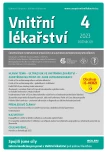Initial use of subcutaneous plasma-derived C1 inhibitor in prophylaxis of acute attacks of hereditary angioedema in pregnant patients in Slovakia
Authors:
Katarína Hrubišková 1; Miloš Jeseňák 2,3; Juraj Payer 1
Authors‘ workplace:
Centrum pre hereditárny angioedém – Expertízne pracovisko MZ SR pre zriedkavé choroby, V. interná klinika Lekárskej fakulty Univerzity Komenského a Univerzitnej nemocnice Bratislava
1; Centrum pre hereditárny angioedém – Expertízne pracovisko MZ SR pre zriedkavé choroby, Klinika detí a dorastu, Klinika pneumológie a ftizeológie, Jesseniova lekárska fakulta v Martine, Univerzita Komenského v Bratislave, Univerzitná nemocnica Martin
2; Oddelenie klinickej imunológie a alergológie, Univerzitná nemocnica Martin
3
Published in:
Vnitř Lék 2023; 69(4): 265-268
Category:
Case reports
doi:
https://doi.org/10.36290/vnl.2023.050
Overview
Hereditary angioedema (HAE) is a rare, inborn disease manifested with recurrent attacks of angioedema. They can affect the skin and subcutaneous tissue, mucous membranes (gastrointestinal, respiratory, and uropoietic tracts), and submucous tissue. Women in reproductive age require specific management of the disease regarding both the course of the disease and treatment options. It is not only the treatment in female patients that is specific, but also the situations (pregnancy, breastfeeding). We present a case report of the initial use of a subcutaneous C1 inhibitor in the long-term prophylaxis of HAE attacks in two pregnant patients.
Keywords:
hereditary angioedema – Prophylaxis – pregnancy
Sources
1. Davis AE 3rd, Mejia P, Lu F. Biological activities of C1 inhibitor. Mol Immunol. 2008 Oct;45(16):4057-63. doi: 10.1016/j.molimm.2008. 06. 028. Epub 2008 Jul 31. PMID: 18674818; PMCID: PMC2626406.
2. Maurer M, et al. The international WAO/EAACI guideline for the management of hereditary angioedema—The 2021 revision and update. Allergy, 2022;77(7): 1961-1990. https://doi.org/10.1111/all.15214.
3. Frank MM, Gelfand JA, Atkinson JP. Hereditary angioedema: the clinical syndrome and its management. AnnIntern Med. 1976;84:580–593.
4. Agostoni A, Aygören‑Pürsün E, Binkley KE, et al. Hereditary and acquired angioedema: problems and progress: proceedings of the third C1 esterase inhibitor deficiency workshop and beyond. J AllergyClinImmunol. 2004;114(suppl 3):S51-S131. doi: 10.1016/j.jaci.2004. 06. 047.
5. Valerieva A, Staevska MT, Grivcheva‑Panovska V, et al. Recombinant human C1 esterase inhibitor for hereditary angioedema attacks: A European registry. WorldAllergy Organ J. 2021 Apr 22;14(4):100535. doi: 10.1016/j.waojou.2021.100535. PMID: 33995818; PMCID: PMC8093463
6. Joseph K, Tholanikunnel BG, Kaplan AP. Cytokine and estrogen stimulation of endothelial cells augments activation of the prekalikrein‑high molecular weight kininogen complex. Implications for hereditary angioedema. J AllergyClinImmunol. 2017;140(1):170-6.
7. Bork K, Men G, StaubachP, Hardt. Hereditary angioedema: new findings concerning symptomas, affected organs, and course. Am J Med.2006;119:267-74.
8. Banerji A, Riedl M. Managing the female patient with hereditary angiedema, WomensHealth (lond). 2016;12:351-61.
9. Caballero T, Farkas H, Bouillet L, et al. International consensus and practical guidelines on the gynecologic and obstetric management of female patients with hereditary angioedema caused by C1 inhibitor deficiency. J AllergyclinImmunol. 2012;129(2):308-20.
10. Hakl R, Kuklínek P, Krčmová I, et al. Treatment of hereditary angioedema attacks with icatibant and recombinant C1 inhibitor during pregnancy. J ClinImmunol. 2018;38(7):810-5.
11. Busse PJ, Christiansen SC, Riedl MA, et al. US HAEA MedicalAdvisoryBoard 2020 Guidelines for the Management of Hereditary Angioedema. J AllergyClinImmunolPract. 2021;9(1):132-150e3.
Labels
Diabetology Endocrinology Internal medicineArticle was published in
Internal Medicine

2023 Issue 4
Most read in this issue
- Osteomalacia
- Point‑of‑Care Ultrasound in internal medicine
- Deep vein thrombosis – the role of ultrasound in the diagnosis and follow-up of patients
- In the prevention of dementia, the focus should be on early and consistent treatment of hypertension
